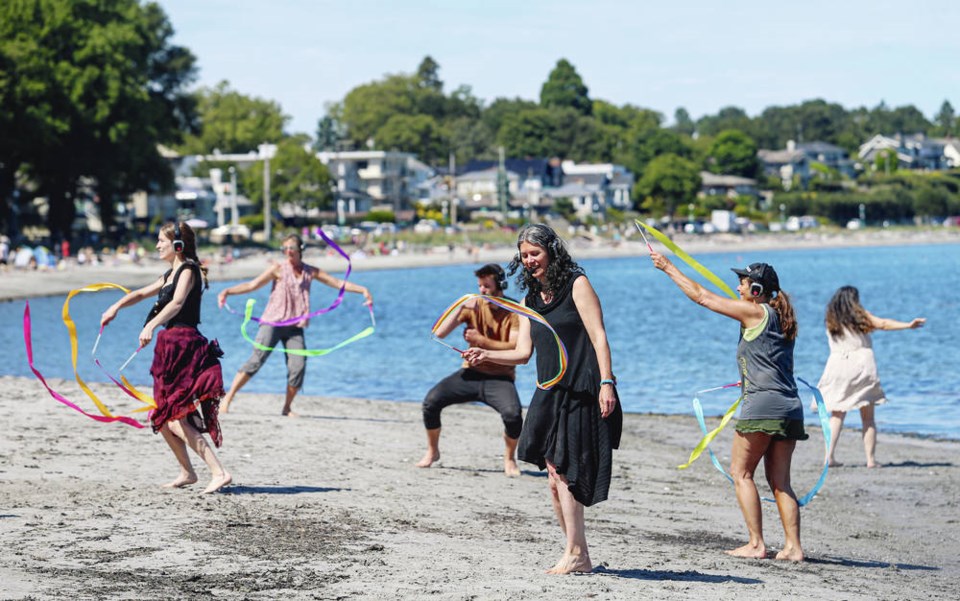Success stories in the the performing arts have been few and far between during the pandemic as artists and event producers struggle to adapt to reduced capacity limits, increased health protocols and non-existent revenue.
New patterns have emerged, however. Small businesses have access to government relief funding, which is designed to encourage new ways of doing business. For occupational therapist Anne Marie Hogya, that meant moving aspects of her practice into the arena of silent dance, where clients and members of the public are led through a multi-faceted therapeutic process — usually outdoors, with each client wearing a Bluetooth headset through which Anne Marie can communicate by microphone.
Events in the city are permitted with an outdoor commercial-use permit from the City of Victoria, with an approved COVID-19 exposure and safety plan in place for all sessions, Hogya said.
“The ‘silent’ part means the whole community around us can’t hear, but everyone who has a headset on has the same experience and can co-exist in an environment together. People can sit, people can stand — you don’t have to be jumping around. A woman who saw us once on the beach, who is 77 and whose husband is in hospice, she called me and said she needed a release, and is now coming to my classes. It’s about people getting into their own bodies, which is cool.”
The idea — which goes by various names starting with the word ‘silent,’ often followed by ‘disco,’ ‘dance,’ or ‘yoga’ — was first introduced on Vancouver Island in 2015 during the festival now known as Cumberland Wild. The Comox Valley event gathered hundreds of revellers under a circus tent at 1 a.m. for a silent disco, with music from live DJs broadcast directly to Bluetooth headphones.
Noise bylaws were not broken, and with full co-operation from area police, patrons wanting to dance into the night had the opportunity to do so.
Silent events have expanded beyond music during the pandemic. Practitioners in the fields of meditation and yoga have adopted the practice, including Sea Cider Farm & Ciderhouse in Saanichton, which has increased its on-site outdoor offerings to included socially distanced headphone yoga through the summer.
Hogya has three five-day dance sessions of classes available through the September as well.
Mary Lloyd of Silent DJ Victoria has been hosting in-person classes via Bluetooth across the city since October. She gathers with groups outdoors for a range of events, from silent dance classes to silent disco parties. Because participants are connected to the music via their headsets, there is not an extensive amount of equipment needed, which means the events can be staged in practically any location at random points in the day.
Her first Silent DJ event took place at Fisherman’s Wharf Park in James Bay. “I did it at night, and back then it got dark early, so the headsets were glowing,” Lloyd said. “The city lights made it all look so beautiful. People were saying how it exhilarating it was.”
Her classes in the months since have been attended by everyone from a mother with a newborn baby wrapped on her chest to a woman in her 80s, she said. She even offered a class for kindergarten students at South Park Family School.
Lloyd is hosting three events this weekend, for dancers of all ages and abilities, on the south end of Willows Beach in Oak Bay, near Bowker Street. Therapeutic dance classes (at 10:45 a.m. and 1:30 p.m.) and an old-growth forests benefit (8 p.m.) are among the dozen she has planned in the coming weeks.
Many of Lloyd’s events have a fundraising component, so her classes bring together a variety of participants. She likens her role to that of a therapeutic dance facilitator. “It’s great having a business where I can make an impact in the community,” Lloyd said. “I love it.”
The holistic benefits are many. Hogya is an occupational therapist as well as a dance instructor; by adopting silent dance, she has been able to blend the clinical and the creative, and has tailored her offerings to engage clients with a variety of mental-health concerns.
“It helps people who need to release and express,” Hogya said. “When they have a headset on, where I can talk to them, and not necessarily be right beside them. I can help them without being intrusive.”
The headsets have a range of several hundred metres, which gives participants a degree of control, should they want to move to an environment where they can feel less self-conscious, she added.
“This morning I was on the beach with people dancing, and this couple walks by, and they had no idea. We can have this whole experience, and no one knows. It’s fascinating.”
Lloyd said the idea of silent events is best summarized by German philosopher Friedrich Nietzsche, who wrote: “And those who were seen dancing were thought to be insane by those who could not hear the music.”
Dancers who partake in her monthly full moon dance classes often draw the most attention, she said. Classes she has led in the snow were also eye-catchers. “There’s a real curiosity and fascination about it,” Lloyd said. “It’s a vicarious kind of enjoyment witnessing these other human beings expressing themselves so freely and spontaneously.
“There is something that really hits a chord with people.”
Information on events by Hogya can be found at annemariehogya.com. Programs by Lloyd can be found at silentdjvictoria.com.
mdevlin@timescolonist.com



